Kerala Plus One Zoology Chapter Wise Questions and Answers Chapter 11 Chemical Coordination and integration
Plus One Chemical Coordination and Integration One Mark Questions and Answers
Question 1.
Listed below are the hormones of anterior pituitary origin. Tick the wrong entry.
(a) Growth hormone
(b) Follicle-stimulating hormone
(c) Oxytocin
(d) Adrenocorticotrophic hormone
Answer:
(c) Oxytocin
Question 2.
Mary is about to face an interview. But during the first five minutes before the interview, she experiences sweating, increased rate of heartbeat, respiration, etc. Which hormone is responsible for her restlessness?
(a) Estrogen and progesterone
(b) Oxytocin and vasopressin
(c) Adrenaline and noradrenaline
(d) Insulin and glucagon
Answer:
(c) Adrenaline and noradrenaline
Question 3.
The steroid responsible for the balance of water and electrolytes in our body is
(a) Insulin
(b) Melatonin
(c) Testosterone
(d) Aldosterone
Answer:
(d) Aldosterone
Question 4.
Name the birth hormone.
Answer:
Oxytocin
Question 5.
A slow runner runs exceptionally fast when a dog chases him. Name the hormone involved in this situation.
Answer:
Adrenaline
Question 6.
Pars intermedia produce hormone. (GH, PRL.TSH, MSH)
Answer:
MSH
Question 7.
The excessive secretion of thyroxine hormone is followed by the enlargement of the thyroid glands. Name the disease occurs due to this,
Answer:
Exophthalmic goiter or Grave’s disease.
Question 8.
Thymosin is responsible for
(a) Raising the blood sugar level
(b) Raising the blood calcium level
(c) Increased production of T lymphocytes
(d) Decrease in blood RBC
Answer:
(c) Increased production of T lymphocytes
Question 9.
In the mechanism of action of a protein hormone, one of the second messengers is
(a) Cyclic AMP
(b) Insulin
(c) 73
(d) Gastrin
Answer:
(a) Cyclic AMP
Question 10.
Note the relationship between the first two words and suggest a suitable word for the fourth place.
- Alpha cell : Glucagon – Beta-cell : __________
- Glucocorticoids : Cortisol – Mineralocorticoids: _________
Answer:
- Insulin
- Aldosterone
Question 11.
Expand the following.
ACTH
Answer:
ACTH – Adreno Cortico Trophic Hormone.
Question 12.
The excessive secretion of thyroxine hormone is followed by the enlargement of the thyroid glands. Name the disease occurs due to this.
Answer:
Exophthalmic goiter or Grave’s disease.
Plus One Chemical Coordination and Integration Two Mark Questions and Answers
Question 1.
Match the following.
| A | B |
| 1. Hyperglycemic hormone | Progesterone |
| 2. Pregnancy hormone | Somatostatin |
| 3. Inhibiting hormone | Glucagon |
| 4. Emergency hormone |
Answer:
- Hyperglycemic hormone – Glucagon
- Pregnancy hormone – Progesterone
- Inhibiting hormone – Somatostatin
Question 2.
Functions of certain hormones are given below. Identify the hormones.
- Regulation of BMR
- Differentiation of T cells
- Stimulate gluconeogenesis, lipolysis and proteolysis.
- Support pregnancy and act on mammary gland and stimulate milk secretion.
Answer:
- Thyroxine
- Thymosin
- Glucocorticoids
- Progesterone
Question 3.
Give example of
- Hyper calcaemic hormone
- Hyperglycemic hormone
Answer:
- PTH (Parathyroid Hormone)
- Glucagon
Question 4.
Name the hormone that regulate each of the following.
- Storage of glucose as glycogen.
- Sodium Potassium metabolism
- Basal Metabolic Rate
- Urinary elimination of water
Answer:
- Insulin
- Aldosterone
- Thyroxine
- ADH
Question 5.
The destruction of adrenal cortex leads to the low production of both glucocorticoids and mineralocorticoids.
- Name the disease occurs due to this.
- Give the symptoms of this disease.
Answer:
- Addison’s disease.
- loose weight, their blood glucose and sodium levels drop and potassium levels rise.
Question 6.
It is necessary to include iodised salt in our diet. Do you agree with this statement? Justify your answer.
Answer:
Yes. Deficiency of iodine in food causes simple goitre.
Question 7.
Diagrammatic representation of the mechanism of action of a steroid hormone is shown here.
- Label A & B
- Name any two protein hormones.

Answer:
- Label A & B
- A – MRNA
- B – Proteins
- FSH, LH
Question 8.
Match the following.
| Hypothalamus | Melatonin |
| Pineal gland | Glucagon |
| Pancreas | Glucocorticoids |
| Adrenal gland | Oxytocin |
| Relaxin |
Answer:
| Hypothalamus | Oxytocin |
| Pineal gland | Melatonin |
| Pancreas | Glucagon |
| Adrenal gland | Glucocorticoids |
Question 9.
Anitha saw a poisonous snake on her way to school. She was frightened and her heart rate and breathing rate increased.
- Name the hormones which are dominant at that time in her blood.
- Which endocrine gland produces the hormone?
- Which is the name given to these hormones?
- To which organ this endocrine gland is attached?
Answer:
- Adrenaline and noradrenaline
- Adrenal gland
- Emergency hormones
- Kidney
Question 10.
Read column A and using the terms given in bracket fill column B.
(Progesterone, Testosterone, Glucagon, Glucocorticoids, Prolactin, Vasopressin, Thymosin, Adrenaline, Follicle Stimulating hormone)
| Endocrine glands (A) | Hormones (B) |
| Hypothalamus | |
| Pituitary | |
| Thymus | |
| Thyroid | |
| Adrenal | |
| Pancreas | |
| Testis | |
| Ovary |
Answer:
| Endocrine glands (A) | Hormones (B) |
| Hypothalamus | Vasopressin |
| Pituitary | Follicle-stimulating Hormone |
| Thymus | Thymosin |
| Thyroid | Thyroxin |
| Adrenal | Glucocorticoids |
| Pancreas | Glucagons |
| Testis | Testosterone |
| Ovary | Progesterone |
Question 11.
Match the following.
| A | B |
| Pineal gland | emergency hormone |
| Hypothyroidism | immune system |
| Thymus | melatonin |
| Adrenal gland | cretinism |
Answer:
| A | B |
| Pineal gland | melatonin |
| Hypothyroidism | cretinism |
| Thymus | immune system |
| Adrenal gland | emergency hormone |
Question 12.
A boy witnessed an accident on his way to school. Following changes occurred in him. (Increased heartbeat, profuse sweating, pupils dilated, shivering, pale face, increased respiration)
- Name the hormone responsible for these changes?
- Name the gland which secretes this hormone?
Answer:
- Adrenaline
- Adrenal gland
Question 13.
After delivery milk ejection starts in human females. It is due to the hormonal interaction. Name the hormones involved in this process.
Answer:
Estrogen, Progesterone, Prolactin and Oxytocin
Question 14.
Diagram shows the location of the various endocrine glands in human body. Identify the labelled parts.
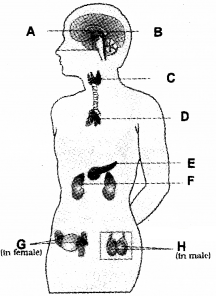
Answer:
- A – Hypothalamus
- B – Thymus
- C – Thyroid gland
- D – Thymus
- E – Pancreas
- F – Adrenal gland
- G – Ovary
- H – Testis
Question 15.
Name a hormone that has the following action and give the source of the hormone.
Regulate blood sugar level – causes it to fall
Answer:
Insulin produced from Islets of Langerhans of pancreas.
Question 16.
Comment on the following flow chart.

Answer:
The figure explain the feed back mechanism between hypothalamus and pituitary by hypothalamo-pituitary axis. It also specifies the existence of feed back control mechanism between the hypothalamo-pituitary axis and other endocrine gland.
Question 17.
Note the relationship and suggest a suitable word in the gap.
- Exocrine: ducted; Endocrine: ______
- Adenohypophysis: Growth _______ hormone; Neurohypophysis: _________
- Glucocorticoid: Cortisol; Mineralocorticoid: __________
- Alpha cells: Glucagon; Beta cells: _________
- Thymus: Infentile gland; Thymosin: __________
- Diabetes mellitus: lnsulin; Diabetes insipidus: _________
Answer:
- ductless gland
- Vasopressin
- Aldosterone
- Insulin
- Infentile hormone
- Vasopressin
Question 18.
Complete the concept map.

Answer:
- A – 80-120 mg/ml
- B – Insulin
- C – Glycogenesis
- D – Glucagon
Question 19.
The male’s body is stronger and rigid than the female’s body. Give reason.
Answer:
Androgens control muscular development in males. These hormones are absent in females.
Question 20.
The sight and sound of a baby can induce the secretion of a hormone in a nursing mother.
- Name the hormone.
- Give the functions of this hormone.
Answer:
- Prolactin
- Prolactin promote growth of mammary gland, secretion of milk and keeps corpus luteum functional.
Question 21.
Pancreas is found to be not functioning in a patient. How this condition will affect physiological functioning in him?
Answer:
Pancreas is a mixed gland, produce hormones and enzymes. Hormonal imbalance problem is due to insulin and glucagon and problems in digestion is due to absence of pancreatic juice.
Question 22.
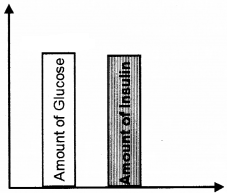
The given bar diagram shows the relative amount of glucose and insulin in a normal man. Redraw the graph to show the conditions in a diabetic patient.
Answer:

Question 23.
Construct a table and arrange the following items in three columns with appropriate headings: Tetany, adenohypophysis, Insulin, Myxoedema, Parathyroid, Dwarfism, Growth hormone, Thyroid, Diabetes mellitus, Pancreas, Thyroxin, PTH.
Answer:

Question 24.
A person with a swelling in the thyroid gland consults a doctor.
- What type of disease does this person have?
- As a student of biology, what remedy would you suggest for these?
Answer:
- Goitre
- Iodine is essential for the functioning of the thyroid gland. It is normally obtained from drinking water and iodised table salt. Other sources are onion, seafood etc.
Deficiency of Iodine causes a disorder known as goitre. In this disorder thyroid glands swell up. So taking adequate amount of Iodised salt is a remedy for goitre.
Question 25.
The destruction of adrenal cortex leads to the low production of both glucocorticoids and mineralocorticoids.
- Name the disease occurs due to this.
- Give the symptoms of this disease.
Answer:
- Addison’s disease.
- Weight loss, blood glucose and sodium levels drop and potassium levels rise.
Question 26.
Match column B & C with column A.
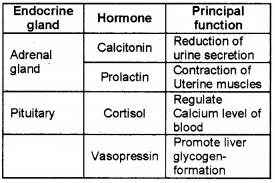
Answer:

Question 27.
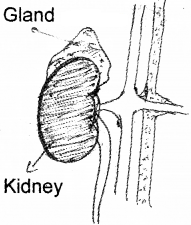
- Identify the gland in the picture.
- How many layers are present in the adrenal gland? Name them and write the hormones from these layers.
Answer:
- Adrenal gland
- Two layers are present in the adrenal gland. They are the outer cortex and inner medulla. Adrenal cortex secretes glucocorticoids, mineralocorticoids and sex corticoids. Adrenal medulla, secretes adrenalin and Noradrenalin.
Question 28.
1. A flowchart showing the process of production of testosterone, is given below.

2. Redraw the chart correctly if there are any mistakes.
Answer:
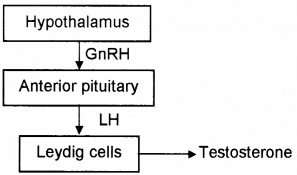
Question 29.
Find the odd one out in each group and give reason.
- TSH, ACTH, FSH, LH, ADH
- Cretinism, Myxoedema, Simple goiter, Gigantism
- Thyrotropin-releasing hormone, Corticotropin-releasing hormone, Gonadotropin-releasing hormone, Somatostatin.
- Adenohypophysis, Neurohypophysis, Hypothalamus, pars intermedia.
Answer:
- ADH, ADH is a hormone from neurohypophysis all others are from the adenohypophysis.
- Gigantism – Gigantism is due to the imbalance of growth hormone, all others are due to the imbalance of thyroid hormone.
- Somatostatin – Somatostatin is an inhibitory hormone, all others are releasing hormone.
- Hypothalamus – remaining three are different parts of the pituitary gland.
Question 30.
Progesterone is called a pregnancy hormone. Do you agree? Give reason.
Answer:
Yes. Progesterone helps in
- Maintenance of pregnancy
- Implantation
- Formation of Placenta
- Growth of mammary glands
Question 31.
Fill in the blanks:
Hormones Target gland
- Hypothalamic hormones _______
- Thyrotrophin(TSH) ____
- Corticotrophin (ACTH)
- Gonadotrophins(LH, FSH)
Answer:
- Hypothalamic hormones Pituitary
- Thyrotroph in (TSH) Thyroid gland
- Corticotrophin (ACTH) Adrenal gland
- Gonadotrophins(LH, FSH) Gonads
Plus One Chemical Coordination and Integration Three Mark Questions and Answers
Question 1.
Can you identify us?
Clue – We are two diseases, one is related to sugar in urine. Our first name is same and the second name is different. Distinguish us.
Answer:
- Diabetes Mellitus and Diabetes insipidus.
- Diabetes mellitus is due to Insulin deficiency and elimination of sugar through urine.
- Diabetes Insipidus is due to ADH deficiency and the elimination of excess water through urine.
Question 2.
When checked the blood sugar of a person, it is found to be 220 mg/100ml of blood; Is this a disorder?
- If this is a disorder, name the disorder.
- Which hormonal imbalance is responsible for this condition?
- Can you suggest any remedial measures to get rid of?
Answer:
- Yes. Diabetes mellitus
- Insulin
- Diet control, Exercise etc.
Question 3.
During Sunbath the body colour is changed.
- Why the body colour is changed?
- Do you think any hormone is responsible for this? If so, name the hormone.
- Explain the action of hormone.
Answer:
- Melanocyte stimulating hormone produced during the sunbath is the reason for the change.
- Melanocyte stimulating hormone from pituitary.
- Melanocyte stimulating hormone (MSH) stimulate cutaneous pigmentation by dispersion of melanin pigments.
Question 4.
A pregnant lady is admitted in a hospital for delivery. But the delivery is delayed than the expected time. Doctor prescribed to take an injection.
- Which hormone is injected to the lady?
- Which glands in the body normally secretes this hormone?
- How does this hormone help in this process?
Answer:
- Oxytocin
- Oxytocin is secreted from pituitary.
- Oxytocin helps the contraction of uterine wall and thereby helps in parturition
Question 5.
Expand the following.
- AMP
- ANF
- ICZN
Answer:
- CAMP – Cyclic Adenosine Mono Phosphate
- ANF – Atrial Natriuretic Factor
- ICZN – International Code of Zoological Nomenclature
Question 6.
The diagram shows the interaction between the hypothalamus, pituitary and thyroid glands. Arrow indicates the probable pathway of direct influence. Answer the following questions.

- Name the hormones A and B.
- State the effect of hormone A on the thyroid.
- State the effect of hormone B on the hypothalamus.
- Describe the control of the pituitary by the hypothalamus in this situation.
Answer:
- A-Thyroid stimulating hormone B-Thyroxine
- Thyroid-stimulating hormone stimulates the thyroid follicle to synthesis two hormones, thyroxine, and triiodothyronine.
- The high level of thyroxin inhibits the production of the thyrotropin-releasing hormone.
- The thyrotropin-releasing hormone of the hypothalamus stimulates the pituitary to release thyrotropin stimulating hormone (TSH) which in turn stimulate the thyroid gland to produce thyroxine
Question 7.
Copy the table and fill in the blanks using appropriate words.

Answer:
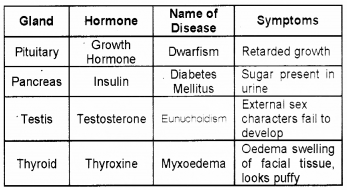
Plus One Chemical Coordination and Integration NCERT Questions and Answers
Question 1.
Give example of:
- Hypercalcemic harmone and hypoglycemic hormone
- Hypercalcemic hormone
- Gonadotropic hormone
- Progestational hormone
- Blood Pressure lowering hormone
- Androgens and estrogens
Answer:
- Hyperglycemic hormone. Glucagon, Hypoglycemic Hormone. Insulin
- Hype – calcemic hormone. Parathyroid Hormone (PTH)
- Gonadotrophic hormones. Luteinizing Hormone and Follicle Stimulating Hormone
- Progestrone and estrogen
- Blood pressure-lowering hormone. Atrial Natriuretic Factor.
- Androgen, Testosterone Estrogens. Estrone, Estradiole, Estriol
Question 2.
Which hormonal deficiency is responsible for the following?
- Diabetes mellitus
- Goitre
- Cretinism
Answer:
- Insulin
- Thyroid
- Thyroid
Question 3.
Briefly mention the mechanism of action of FSH
Answer:
In males, FSH and androgens regulate spermatogenesis. FSH stimulates the growth and development of the ovarian follicles in females.
Question 4.
Match the following.
| Column I | Column II |
| (a) T4 | (i) Hypohtalamus |
| (b) PTH | (ii) Thyroid |
| (c) GnRH | (iii) Pituitary |
| (d) LH | (iv) Parathyroid |
Answer:
(a) – (ii)
(b) – (iv)
(c) – (i)
(d) – (iii)
Plus One Chemical Coordination and Integration Multiple Choice Questions and Answers
Question 1.
Endemic goitre is a state of
(a) increased thyroid function
(b) normal thyroid function
(c) decreased thyroid function
(d) moderate thyroid function
Answer:
(c) decreased thyroid function
Question 2.
Name the hormone that stimulates the secretion of gastric juice.
(a) Rennin
(b) enterokinase
(c) Enterogastrone
(d) gastrin
Answer:
(d) gastrin
Question 3.
Islets of Langerhans are found in
(a) anterior pituitary
(b) kidney cortex
(c) spleen
(d) endocrine pancreas
Answer:
(d) endocrine pancreas
Question 4.
The hormone responsible response flight, flight and fight response is
(a) adrenalin
(b) thyroxin
(c) ADH
(d) oxytocin
Answer:
(a) adrenalin
Question 5.
Foetal ejection reflex in human female is induced by
(a) pressure exerted by amniotic fluid
(b) release of oxytocin from pituitary
(c) fully developed foetus and placenta
(d) differentiation of mammary glands
Answer:
(b) release of oxytocin from pituitary
Question 6.
A health disorder that results from the deficiency of thyroxin in adults and characterized by
(i) a low metabolic rate
(ii) increase in body weight
(iii) tendency to retain water in tissues is
(a) hypothyroidism
(b) simple goitre
(c) myxoedema
(d) cretinism
Answer:
(c) myxoedema
Question 7.
Gland responsible for calcium metabolism is
(a) thymus
(b) thyroid
(c) parathyroid
(d) adrenal
Answer:
(c) parathyroid
Question 8.
Secretion is under control of neurosecretory nerve axons in
(a) pineal gland
(b) adrenal cortex
(c) anterior pituitary
(d) posterior pituitary
Answer:
(d) posterior pituitary
Question 9.
The smallest endocrine gland is
(a) thyroid
(b) parathyroid
(c) pituitary
(d) adrenal
Answer:
(c) pituitary
Question 10.
Gigantism and acromegaly are due to
(a) hypothyroidism
(b) hyperthyroidism
(c) hypopituitarism
(d) hyperpituitarism
Answer:
(d) hyperpituitarism
Question 11.
Spermatogenesis is under the regulatory influence of
(a) ADH
(b) FSH
(c) LH
(d) STH
Answer:
(b) FSH
Question 12.
Which hormone is secreted in a woman if pregnancy has occurred?
(a) Oestrogen
(c) Luteinizing hormone
(d) Chorionic gonadotrophin
Answer:
(d) Chorionic gonadotrophin
Question 13.
Insulin and glucagon are transported to target organ by
(a) lymph
(b) blood
(c) pancreatic duct
(d) cystic duct
Answer:
(d) cystic duct
Question 14.
Neurons of people suffering from diabetes insipidus do not secrete
(a) enzyme
(b) steroid
(c) fatty acid
(d) ADH
Answer:
(d) ADH
Question 15.
The hormone that increases the blood calcium level and decreases its excretion by kidney is
(a) parathormone
(b) calcitonin
(c) thyroxin
(d) insulin
Answer:
(a) parathormone
Question 16.
If the pituitary gland of an adult rat is surgically removed, which of the following endocrine glands will be less affected?
(a) Adrenal cortex
(b) Adrenal medulla
(c) Thyroid
(d) Gonads
Answer:
(b) Adrenal medulla
Question 17.
Oestrogen and testosterone are steroid hormones, and are most likely bind to
(a) membrane ions channels
(b) enzyme-linked membrane receptors
(c) G-protein linked membrane receptors
(d) cytoplasmic receptors
Answer:
(d) cytoplasmic receptors
Question 18.
Steroid hormones easily pass through the plasma membrane by simple diffusion because they
(a) are water soluble
(b) contain carbon and hydrogen
(c) enter through pores
(d) are lipid soluble
Answer:
(d) are lipid soluble
Question 19.
A hormone secreted by the endocrinal cells of duodenal mucosa which influences the release of pancreatic juice is
(a) relaxin
(b) cholecystokinin
(c) secretin
(d) progesterone
Answer:
(b) cholecystokinin
Question 20.
Which of the following hormones does not contain a polypeptide?
(a) Prostaglandin
(b) Oxytocin
(c) Insulin
(d) Antidiuretic hormone
Answer:
(b) Oxytocin
